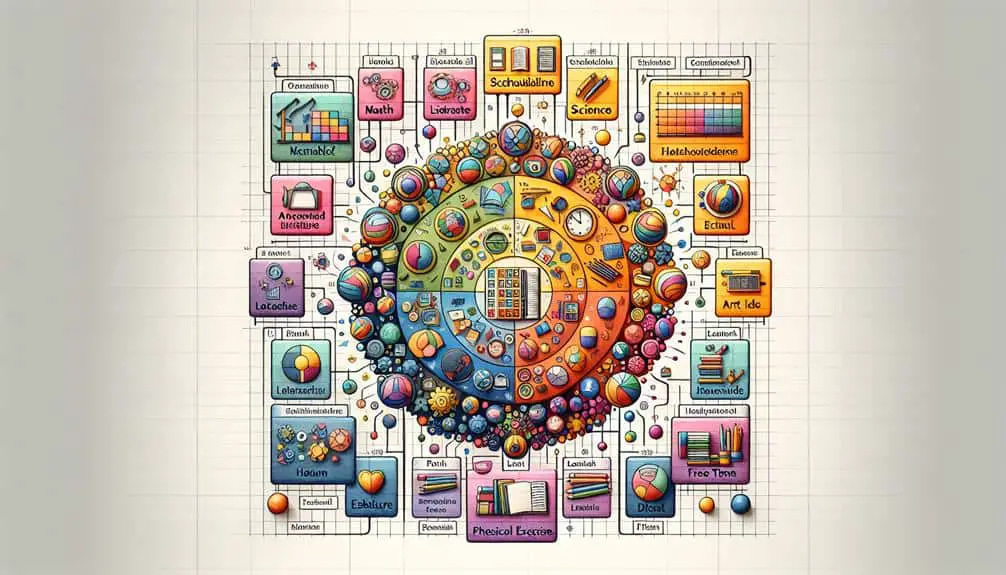Visual homeschooling schedules benefit you by boosting organization, productivity, catering to diverse learning styles, enhancing engagement, and nurturing independent time management skills. By incorporating visual aids like charts and color-coding, these schedules improve comprehension and retention. They help students follow daily routines effectively, reducing anxiety and improving focus. When students actively participate in creating these schedules, they develop a sense of ownership and responsibility. Implementing visual schedules within your routine enhances educational effectiveness and student engagement. Discover more about the advantages of visual homeschooling schedules by exploring how they foster autonomy and enhance retention.
Key Points
- Enhance student organization and productivity.
- Aid in understanding and following daily routines effectively.
- Improve student engagement and reduce anxiety.
- Cater to different learning styles for better comprehension.
- Foster autonomy and responsibility in time management.
Importance of Visual Learning Styles
Visual learning styles play an essential role in education, as they cater to individuals who process information more effectively through images, charts, and other visual aids. These learners benefit greatly from seeing information presented visually rather than through auditory or written means. By incorporating visual aids into educational materials, such as infographics, diagrams, and videos, educators can enhance comprehension and retention for students with visual learning preferences. Understanding different learning styles, including visual, auditory, and kinesthetic, allows for a more inclusive and effective teaching approach.
Research indicates that approximately 65% of the population are visual learners. For these individuals, visual aids serve as powerful tools to grasp complex concepts, facilitate better understanding, and improve memory recall. By tapping into visual learning styles, educators can create engaging and interactive lessons that cater to a broader range of students, ultimately leading to more profound learning outcomes.
Embracing visual learning styles in education not only benefits visual learners but can also enhance the overall learning experience for all students.
Creating Visual Homeschooling Timetables
Crafting visually appealing homeschooling timetables can improve organization and productivity for both parents and students. When designing these schedules, consider using visual aids such as charts, color coding, or illustrations to help in time management and organization.
Visual representations of the daily or weekly plan can make it easier for students to understand and follow their tasks, leading to a more structured learning environment.
To create an effective visual homeschooling timetable, start by outlining the subjects or activities that need to be covered each day. Use different colors for each subject to aid in categorization and quick identification. Incorporating images related to the tasks can also enhance creativity and engagement.
Make sure that the timetable is clear, easy to read, and prominently displayed in the learning space. Encouraging students to participate in the creation process can also foster a sense of ownership and responsibility towards their schedule.
Utilizing Color Coding for Organization
When organizing your homeschooling schedule, consider using color-coded task blocks to categorize subjects or activities efficiently. Research shows that color coding can enhance visual clarity and focus, making it easier for both parents and students to navigate the daily routine.
Color-Coded Task Blocks
Implementing color-coded task blocks in your homeschooling schedule can greatly enhance organization and productivity. By utilizing color coding for task prioritization and time management, you can visually organize your day in a way that aids cognitive processing.
Assigning specific colors to different subjects or types of activities can help you quickly identify and prioritize tasks. For example, you could use red for math assignments, blue for reading activities, and green for science experiments. This visual organization allows for easier recognition of different tasks and helps in efficiently managing your time.
Research has shown that color coding can improve memory retention and information recall, making it an effective tool for enhancing learning outcomes. When you visually separate tasks using distinct colors, your brain can process information more effectively, leading to improved focus and productivity.
Additionally, color coding can help reduce decision fatigue by providing a clear visual guide on what needs to be done next. By incorporating color-coded task blocks into your homeschooling schedule, you can optimize your time management skills and create a more structured and engaging learning environment.
Visual Clarity and Focus
In addition, color coding your homeschooling schedule can provide visual clarity and focus, enhancing organization and productivity in your daily tasks. By assigning specific colors to different subjects, activities, or individuals, you can create a system that allows for quick identification and improved concentration.
When you glance at your schedule and see vibrant colors highlighting various tasks, it offers a clear direction on what needs to be done, reducing decision fatigue and increasing efficiency.
Research shows that color coding can help stimulate the brain and enhance memory retention. The visual cues provided by color can trigger associations and assist in recalling information more effectively. This technique is especially beneficial for visual learners who thrive on visual aids to process information.
Additionally, color coding your schedule can create a visually appealing environment that can motivate and engage you and your children in the learning process. By implementing this simple yet powerful strategy, you can cultivate a focused and organized homeschooling routine that promotes better learning outcomes.
Enhancing Learning Environment
Color coding your homeschooling schedule not only enhances organization and productivity but also creates an ideal learning environment that fosters engagement and motivation for both you and your children.
By utilizing color-coded visuals in your homeschooling space, you can greatly improve spatial organization and overall classroom decorations. Research suggests that color coding helps individuals, especially children, categorize information, making it easier to process and remember.
When you incorporate color-coded elements into your learning environment, you create a visually stimulating space that can enhance focus and cognitive abilities. For instance, using different colors for various subjects or tasks can help in quickly identifying and shifting between different activities throughout the day. This method not only aids in spatial organization but also adds a fun and engaging aspect to the learning process.
Moreover, color coding can assist in creating a more structured and visually appealing homeschooling area. Organizing materials, schedules, and resources by color can reduce clutter and create a sense of order that's essential for a productive learning environment.
Incorporating Images and Icons
When creating your homeschooling schedule, consider incorporating images and icons to enhance visual learning aids and help organize your time effectively.
Utilizing iconic time blocks can make it easier for you and your child to understand the schedule at a glance, improving overall productivity and engagement.
Research suggests that visual aids can greatly benefit learning outcomes, making this a valuable addition to your homeschooling routine.
Visual Learning Aids
Incorporating visual aids such as images and icons can greatly enhance the learning experience for homeschooling students by providing engaging and memorable representations of information. Visual aids cater to different learning styles, making it easier for visual learners to grasp concepts effectively.
By including images and icons in homeschooling timetables, students can better understand the sequence of tasks and activities, aiding in organization and time management skills.
Research shows that visual aids can improve information retention by up to 65%, making them a valuable tool in the homeschooling environment. These aids help break down complex topics into simpler, more digestible forms, facilitating better comprehension and long-term memory recall.
Additionally, visual learning aids stimulate creativity and critical thinking, encouraging students to connect ideas visually and think outside the box.
Therefore, incorporating visual aids in homeschooling schedules not only enhances organization and time management but also enriches the learning experience, catering to various learning styles and promoting better retention of information.
Iconic Time Blocks
Enhance your homeschooling schedule by visually representing different time blocks with iconic images and icons, aiding in task organization and time management skills.
Utilizing visual cues for time management can greatly improve your productivity and help you stay on track with your daily activities. By assigning specific icons to different subjects or tasks, you can create a clear visual representation of your schedule, making it easier to prioritize tasks effectively.
Color coding your iconic time blocks can further enhance your organization by associating different colors with various subjects or activities. This method can help you quickly identify different types of tasks at a glance, allowing for efficient task prioritization throughout your day.
Research shows that color coding can stimulate the brain and improve memory retention, making it a valuable tool for homeschooling success.
Incorporating iconic time blocks into your homeschooling schedule can streamline your daily routine, improve time management skills, and enhance overall productivity. By visually representing your tasks, you can create a structured and efficient learning environment that promotes focus and organization.
Benefits of Visual Schedules for Students
Utilizing visual schedules can greatly enhance a student's organization, time management, and overall productivity in the homeschooling setting. Visual aids play an essential role in helping students understand and follow their daily routines effectively. By having a clear visual representation of their schedule, students can easily grasp the tasks at hand, which can lead to improved time management skills.
Research suggests that visual schedules can greatly enhance student engagement. When students can see what activities are coming up next, it helps them mentally prepare for changes, reducing anxiety and increasing focus. This engagement with their schedule can lead to a smoother flow of activities throughout the day, ultimately boosting productivity.
Moreover, visual schedules cater to different learning styles, making it easier for students to comprehend and follow instructions independently. This can foster a sense of autonomy and responsibility in students, as they learn to manage their time effectively based on the visual cues provided.
Enhancing Engagement and Retention
To optimize engagement and retention in homeschooling, it's essential to implement visual schedules effectively within the daily routine. Visual schedules not only provide a clear outline of the day's activities but also offer interactive engagement for students. By incorporating visual stimulation through color-coded subjects or icons representing tasks, students are more likely to stay focused and actively participate in their learning process.
Research indicates that visual aids enhance educational effectiveness by catering to various learning styles, such as visual and kinesthetic learners. When students can visually see their tasks laid out, it helps them better understand and remember the information presented. This, in turn, leads to improved retention of the material covered.
Furthermore, interactive engagement with visual schedules allows students to take ownership of their learning journey. Encouraging them to participate in creating or modifying the schedules can foster a sense of responsibility and independence, further enhancing their educational experience.
Frequently Asked Questions
How Can Visual Schedules Accommodate Different Learning Paces?
To accommodate different learning paces, use visual schedules for individualized pacing. Tailor tasks to learning styles, allowing flexibility and clear progression. Visual aids enhance understanding and organization, supporting diverse learners effectively in a homeschooling environment.
What Tools Can Be Used to Create Visually Appealing Timetables?
To craft visually appealing timetables, you can harness your creativity through various digital tools. Explore creative layouts using platforms like Canva or Excel. These tools offer flexibility to design schedules that engage and organize your homeschooling journey effectively.
Are There Recommended Color Schemes for Effective Organization?
When creating homeschool schedules, color coordination is essential for effective organization. Use a color scheme that aligns with your preferences and aids visual memory. Bright, contrasting colors for different subjects or activities can enhance focus and retention.
How Do Images and Icons Aid in Memory Retention?
When learning, images and icons aid in memory retention by enhancing cognitive benefits. Visual aids offer educational advantages, improving comprehension and recall. By utilizing these tools effectively, you can boost your understanding and retention of information.
Can Visual Schedules Improve Time Management Skills?
When you use personalized visual schedules, time efficiency can improve greatly. Combine learning retention with clear, colorful icons. Visual aids help you manage tasks effectively, making your homeschooling experience more organized and successful.



